As an Amazon Associate, I earn from qualifying purchases.
A step-by-step tutorial on Canning Whole Tomatoes. This easy-to-follow process is perfect for beginners and covers preserving tomatoes in both water bath and pressure canning methods.
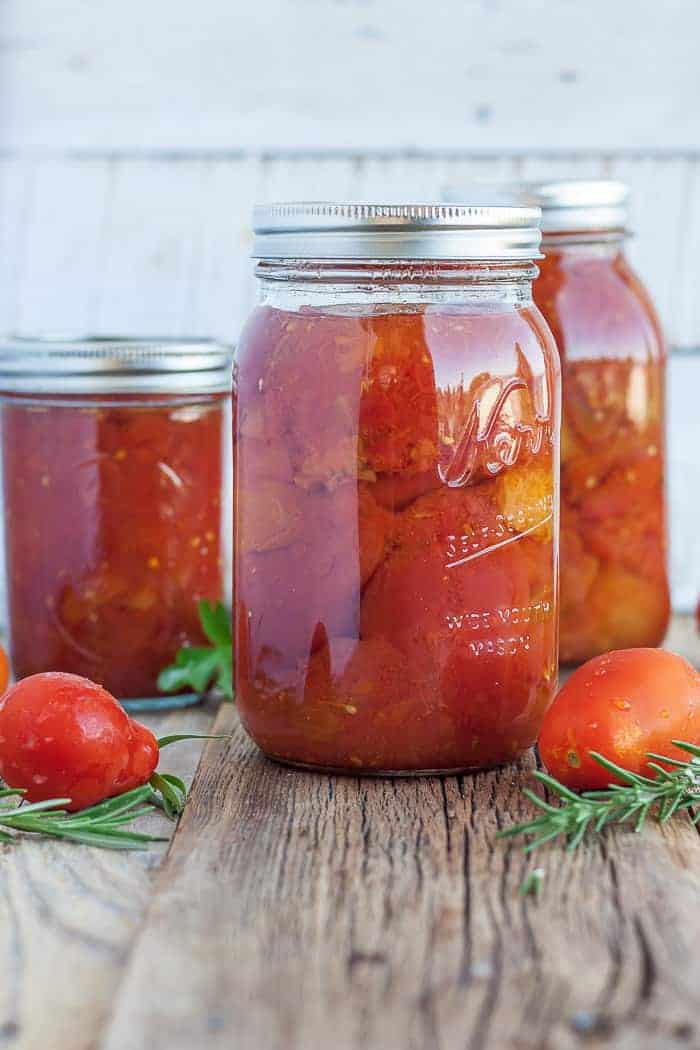
Whole peeled tomatoes are one of the most versatile foods you can have in your pantry. They’re great for making pasta sauce, to add to stews, and they are the shining star in my gluten-free tomato soup.
This recipe has both waterbath and pressure canning instructions so you can choose the method that works best for you. In my experience, it is a faster process in a pressure canner.
HOW MANY TOMATOES DO YOU NEED FOR CANNING?
This recipe will fill 7-quart jars. For 7 quarts you will need about 21 pounds of fresh tomatoes. It works out to about 3 pounds per quart. A quart jar will replace the 28-48 oz cans of tomatoes from the grocery store.
If you are canning pints of whole tomatoes, you’ll need approximately 13 pounds for 9 pints. A pint jar will replace the 13-16 oz cans of tomatoes from the grocery store.
If purchasing your tomatoes in bulk, a bushel weighs 53 pounds and will yield approximately 15-21 quarts.
It is best to use low-moisture tomatoes like romas.
WHY DO I NEED BOTTLED LEMON JUICE?
The lemon juice is needed to regulate the acidity of the fruit to keep the ph level consistent. Storebought lemon juice generally has the same level of acidity (5%) from bottle to bottle. You don’t get that guarantee with freshly squeezed lemons.
RAW PACK FOR CANNING Tomatoes
Raw packing simply means placing the peeled tomatoes in the jars without precooking them, filling the jars with boiling water, and processing them in the canner.
Raw packing is much faster than a hot pack process, but there are some drawbacks. No matter how well you pack the jars, the density of the tomatoes will change during their time in the canner.
This often leads to something called “fruit float” in which the fruit will float to the top of the jar, leaving water (in my house, we jokingly call it tomato pee) on the bottom. You’ll find this when you’re canning pears and canning peaches as well. There is nothing wrong with fruit float as long as your jars are still sealed.
HOT PACK FOR CANNING tomatoes
Hot packing whole tomatoes involves cooking them in boiling water for 5 minutes before packing them into jars for canning. The appeal of hot packing are that you typically can fit more per jar, and the near elimination of fruit float.
The drawback is that it takes longer.
Canning Whole Tomatoes
I’ll walk you through the process here in photos because it really helps, especially if you’re new to canning. At the bottom of the post, you’ll also find a printable and detailed recipe card.
Rinse your tomatoes in a strainer. Using a paring knife, remove the stem/core. Place the tomato in a large bowl. I like to core about 75% of them at all once before the next step.
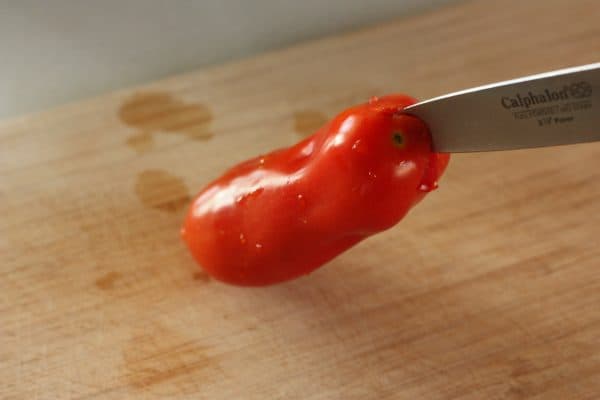
Prepare a large bowl with ice water.
Wash and clean your jars. It is no longer necessary to sterilize jars before canning (hurray!) but you should make sure they are preheated enough to not crack when placed in hot water.
You can put them in a clean dishwasher and run them through a quick wash cycle, or place them in a large pan with some water in a low-heat oven (my lowest temp is 170˚F degrees) until you need them. I’ve even just put super hot tap water in them before and left them on the counter.
Wash your lids with hot soapy water and place them in a clean bowl for now.
(If you’re a giant nerd/curious, you can read more about this next step in-depth in this tutorial on How to Blanch and Peel Tomatoes) Add the tomatoes to a pot of boiling water and parboil them until you see the skins start to come off (about 1-2 minutes).
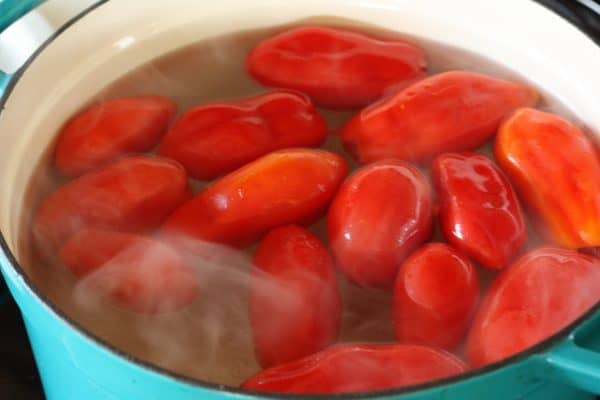
Using a slotted spoon, remove the tomatoes and place them in the ice water.
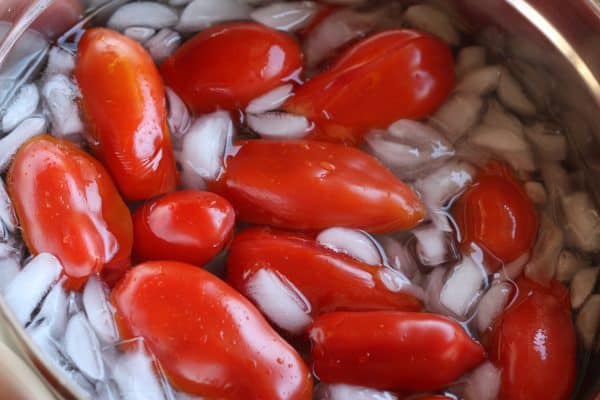
Working one at a time, remove any skin that hasn’t already slipped off. Set the skins aside to make Homemade Tomato Powder.
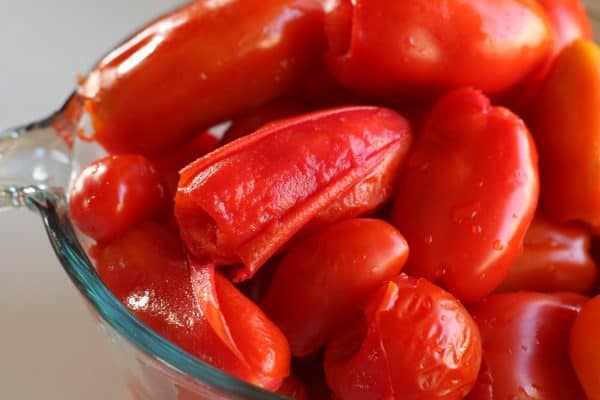
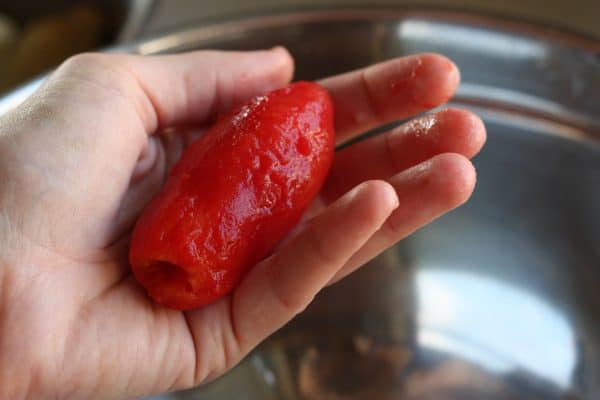
Once the tomatoes have been peeled, you can slice the tomatoes in half or leave them whole. The nice part about of cutting them in half is that you can remove the seeds. The appeal of leaving them whole is it is easier and faster!
If you are hot packing your tomatoes, add the peeled tomatoes to a pot of boiling water and let them cook for 5 minutes.
Add 3 quarts of water to your pressure canner and put it on a burner set to high. Make sure there is a canning rack in the bottom of the canner.
Add lemon juice or citric acid to your canning jars (see recipe card below for exact measurements).
Using a canning funnel, ladle hot tomatoes into the jars. Ladle in clean boiling water, leaving 1/2 inch headspace.
Using a long utensil (I prefer a plastic chopstick), remove all the air bubbles from the jar.
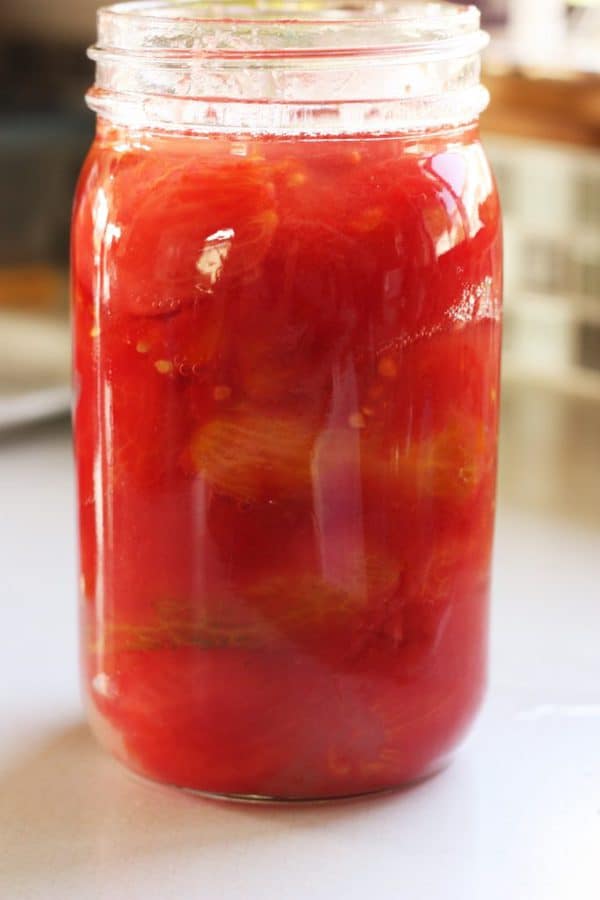
Clean the rim of the jar very well with a hot damp rag. Any juice or bits of tomato left on the rim may impact the seal of the lid in the canner.
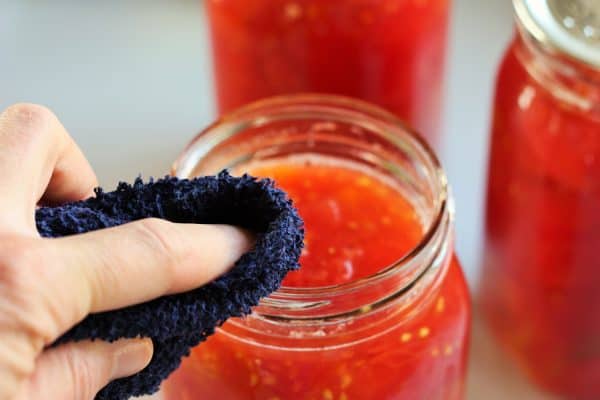
Place a clean lid on the jar. Add a ring, and tighten it to fingertip tight.
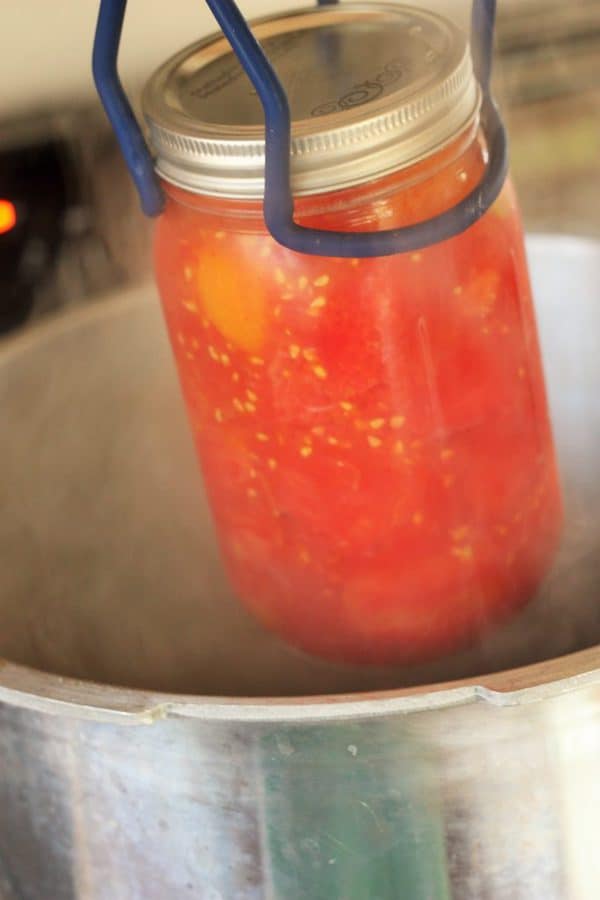
Using canning jars, place the jars in the canner. If you don’t have enough jars to fill the canner, consider Canning Water in a few jars to stock your emergency drinking water supplies.
Lock the lid. Soon, steam will start coming through the vent pipe (I call it the steam chimney). Allow the steam to pass through for about 10 minutes. Then put the pressure regulator (I call it the chimney cap) on top.
Pretty soon, the air vent will pop up. That is a sign that you’re starting to build pressure inside the canner. Get excited, nerd!
See the chart below for processing times.
Pressure Canning Whole Tomatoes in a Dial-Gauge Pressure Canner
| Canner Pressure (PSI) at Altitudes of | ||||||
| Style of Pack | Jar Size | Processing Time | 0-2,000 ft | 2,001-4,000 ft | 4,001-6,000 ft | 6,001-8,000 ft |
| Hot or Raw | Pints or Quarts | 15 mins | 6 lbs | 7 lbs | 8 lbs | 9 lbs |
| 10 mins | 11 lbs | 12 lbs | 13 lbs | 14 lbs | ||
| *Source: National Center For Home Food Preservation | ||||||
Processing Time for Whole Tomatoes in a Weighted-Gauge Pressure Canner
| Canner Pressure (PSI) at Altitudes of: | ||||
| Style of Pack | Jar Size | Processing Time | 0-1,000 ft | Above 1,001 ft |
| Hot and Raw | Pints & Quarts | 15 mins | 5 lb | 10 lb |
| 10 mins | 10 lb | 15 lb | ||
| 1 min | 15 lbs | Not recommended | ||
| *Source: National Center For Home Food Preservation | ||||
When the dial gauge reaches the appropriate PSI, reduce the burner temp to medium, and start your timer. The pressure must stay at the PSA or (a little bit) above for the duration of the cooking time. You’ll likely need to adjust the temp on the burner a few times depending on your stove.
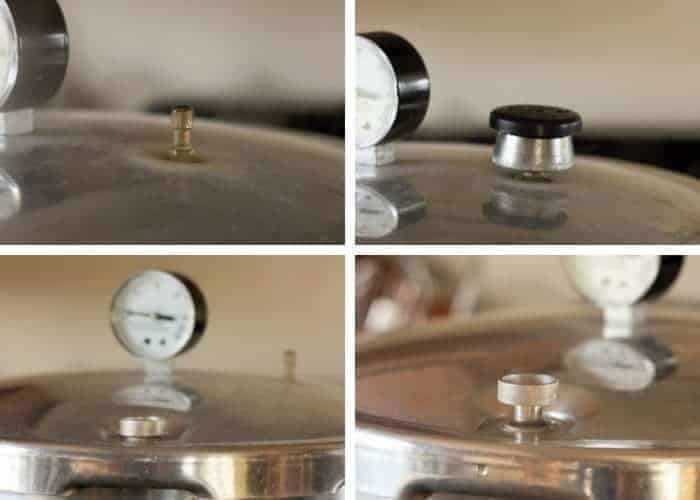
When the time is up, remove the canner from the burner and allow it to sit until you hear a distinctive “click” of the air vent dropping. Remove the pressure regulator and carefully remove the lid of the canner (Pro tip: I always use oven mitts when I take the lid off because the steam is super hot).
Place hot jars on a towel where they can sit undisturbed for 12 hours.
After a few hours, to check for sealing, gently press down in the middle of the lid. If the lid has no give, it’s sealed. If you can press the lid in and it pops a bit, your jars are not sealed.
Water Bath Canning Whole Tomatoes
You’ll find instructions on water bath canning the tomatoes in the printable recipe card below, but I’ll leave a handy-dandy processing time chart here for you:
Processing Time for Whole Tomatoes
| Processing Time for Whole Tomatoes | |||||
| Process Times at Altitudes of: | |||||
| Style of Pack | Jar Size | 0-1,000 ft | 1,001-3,000 ft | 3,001-6,000 ft | Aove 6,000 ft |
| Hot and Raw | Pints | 40 min | 45 min | 50 min | 55 min |
| Quarts | 45 min | 50 min | 55 min | 60 min | |
| *Source: National Center For Home Food Preservation | |||||
Storage
Once the jars have sealed, remove the rings. Label and store sealed jars in a cool (best results are 50-70˚F) dark place for up to 12-18 months.
If you have the space available, do not stack the jars on top of each other more than two jars high.
Help! Why are the jars leaking juice?
If you find that juice has leaked out after they have sealed, you have experienced a common canning issue called siphoning. It happens to the best of us!
Siphoning is typically caused by not allowing the jars to rest in the canner after they have finished processing. In the directions, you’ll see that I recommend you remove the canner from the burner, remove the lid, and let it sit for 5 minutes.
This is important as it allows the jars time to rest before being allowed to cool on the counter. Doing this process will significantly cut down on siphoning.
IF YOU HAVE SIPHONING IN YOUR JARS, FOLLOW THESE STEPS:
- Check – are the lids still sealed?
- Look – have you lost less than half of the amount of liquid in the jar?
- Examine – do the tomatoes still look fresh with bright colors?
If the answer to the above three steps is “yes!”, then they are safe to eat.
What if my jars don’t seal?
If you’ve correctly processed your tomatoes, and the lids still didn’t seal, you can reprocess them.
Double-check to make sure there are no:
- Chips in the rim of the jar
- Dried juice or bits of tomato on the rim (anything between the rim and the lid may prevent a seal.
Best practices would involve using brand-new lids for reprocessing. Set aside the old lids to use for dry storage.
If the jars don’t seal on the second attempt, you likely have a bad batch of lids, or your canning process has a step missing. Email me and we’ll try to troubleshoot what is going on.
Pro Tips/Recipe Notes:
- You can add salt to each jar prior to canning it. Use pickling salt and add 1/2 tsp per quart. Personally, I find unsalted whole peeled tomatoes easier to use in recipes because it allows me to control the overall sodium.
- Pressure canners can often leave white lines on lids and rings. It’s totally normal and safe. To prevent this, add 1/3 cup of white vinegar to the canner before processing.
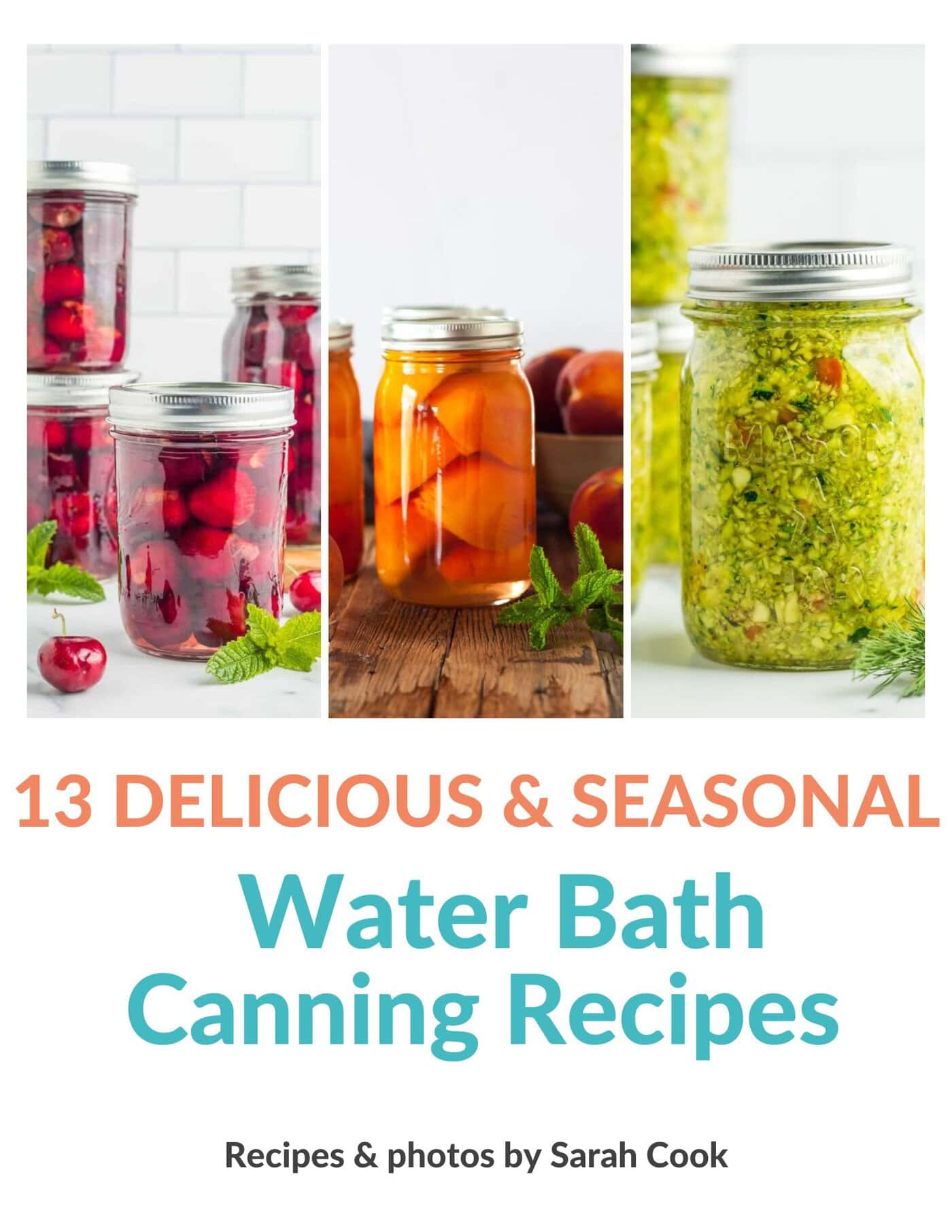
Get my Canning e-book!
It’s 51 pages of every helpful tip and trick you could want as a brand new canner, AND it includes 13 ad-free canning recipes that are designed to take you from novice to pro.
Canning Whole Tomatoes
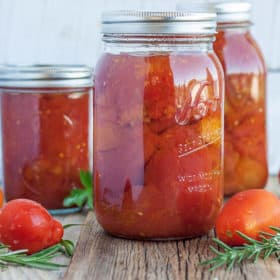
Equipment
Ingredients
- 21 lbs tomatoes
- 14 tbsp bottled lemon juice (2 tbsp per quart)
Instructions
How to Pressure Can Whole Tomatoes
- Rinse your tomatoes. It is best to use a low-moisture tomato like romas.21 lbs tomatoes
- Using a paring knife, remove the stem/core from the tomatoes. Place in a large bowl. I like to core about 75% of them at all once.
- Wash and sanitize your jars. You’ll want to keep them warm to avoid having them crack when placed in the canner. You can fill them with hot water, or place them on a tray in the oven at 170˚F.
- Wash your lids with hot soapy water and place them in a clean bowl for now.
- Fill a large saucepan with water and bring it to a boil.
- Prepare a large bowl with ice water. Set aside.
- Add the tomatoes to a pot of boiling water and parboil them until you see the skins start to come off the tomatoes (about 1-2 minutes).
- Use a slotted spoon and remove the tomatoes and place in the ice water.
- Working with the tomatoes one at a time, remove any skin that hasn’t already slipped off.
- Once they are peeled you can slice the tomatoes in half (to remove all the seeds) or leave them whole.
- If you are hot packing your tomatoes add them to a pot of boiling water and let them cook for 5 minutes.
- Add 3 quarts of water to your pressure canner and put it on a burner set to high. Make sure there is a canning rack in the bottom of the canner.
- Add lemon juice or citric acid to your canning jars. Quarts: 2 tbsp lemon juice OR 1/2 tsp citric acid. Salt (optional) 1 tspPints: 1 tbsp lemon juice OR 1/4 tsp citric acid. Salt (optional) 1/2 tsp14 tbsp bottled lemon juice
- Using a canning funnel, ladle hot tomatoes in the jars. Cover tomatoes with clean boiling water.
- Leave 1/2 inch headspace. Headspace is the distance between the top of the food and the top of the jar.
- Using a long utensil (I prefer a plastic chopstick), remove all the air bubbles from the jar.
- Clean the rim of the jar very well with a hot damp rag.
- Place a clean new lid on the jar. Add a ring, and tighten to fingertip tight.
- Using canning tongs, gently place the jars in the canner.
- Lock the lid. Soon, steam will start coming through the vent pipe. Allow the steam to pass through for about 10 minutes. Then put the pressure regulator on top.
- Pretty soon, the air vent will pop up.
- In a dial-gauge pressure canner, process pints and quarts based on the elevation guide below:*0-2,000f ft {PSI: 6 lbs of pressure} = Pints & Quarts 15 min*0-2,000f ft {PSI: 11 lbs of pressure} = Pints & Quarts 10 min*2,001-4,000k ft {PSI: 7 lbs of pressure} = Pints & Quarts 15 min*2,001-4,000k ft {PSI: 12 lbs of pressure} = Pints & Quarts 10 min*4,001-6,000k ft {PSI: 8 lbs of pressure} = Pints & Quarts 15 min*4,001-6,000k ft {PSI: 13 lbs of pressure} = Pints & Quarts 10 min*6,001-8,000k {PSI: 9 lbs of pressure} = Pints & Quarts 15 min*6,001-8,000k {PSI: 14 lbs of pressure} = Pints & Quarts 10 min
Water Bath Canning Instructions
- Prepare your water bath canner by filling it with water. You just need to have enough water to cover the jars by 1 inch once the water is boiling.
- Set the canner fitted with the lid on the stove. Turn the burner to high. Once it reaches a boil, reduce it to simmer. You want to keep the water hot so that everything is ready when the tomatoes are.
- Follow steps 1-18 above in the Pressure Canning Instructions.
- Return the water in the canner to a rolling boil.
- Using canning tongs, carefully lower the jars into the boiling water and place the lid on and set your timer. The water must return to a full rolling boil before you start your timer.
- Process pints and quarts based on the elevation guide below:*0-1,000 ft – Pints =40 min Quarts =45 min*1,001-3,000 ft – Pints =45 min Quarts =50 min*3,001-6,000 ft – Pints =50 min Quarts =55 min*6,000 ft+ – Pints =55 min Quarts =60 min
- When the time is up, remove the canner from the burner and let the jars sit for 5 minutes in the canner and then lift them out with canning tongs.
- Place on a towel where they can sit undisturbed for 12 hours.
Notes
- 22 lbs tomatoes per 7 quarts, or 14 lbs tomatoes per 9 pints. About 3 lbs tomatoes per quart.
- Once the jars have sealed, remove the rings. Label and store sealed jars in a cool (best results are 50-70˚F) dark place for up to 12-18 months.
Nutrition
Nutrition information is automatically calculated, so should only be used as an approximation.

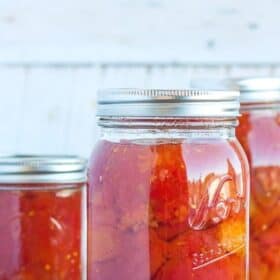
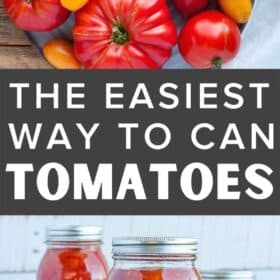


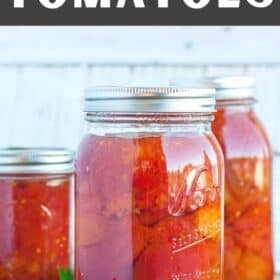

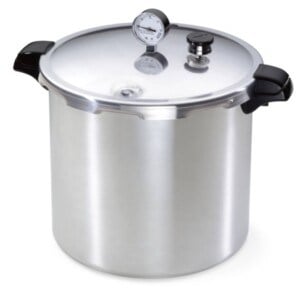
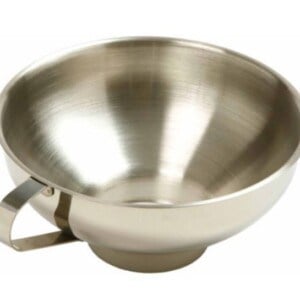
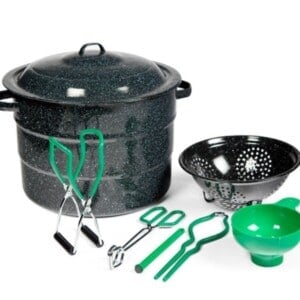
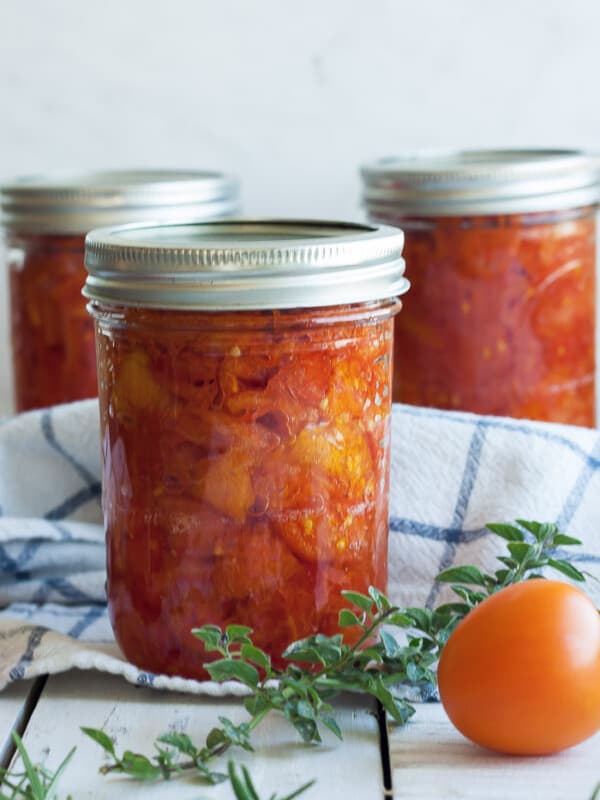
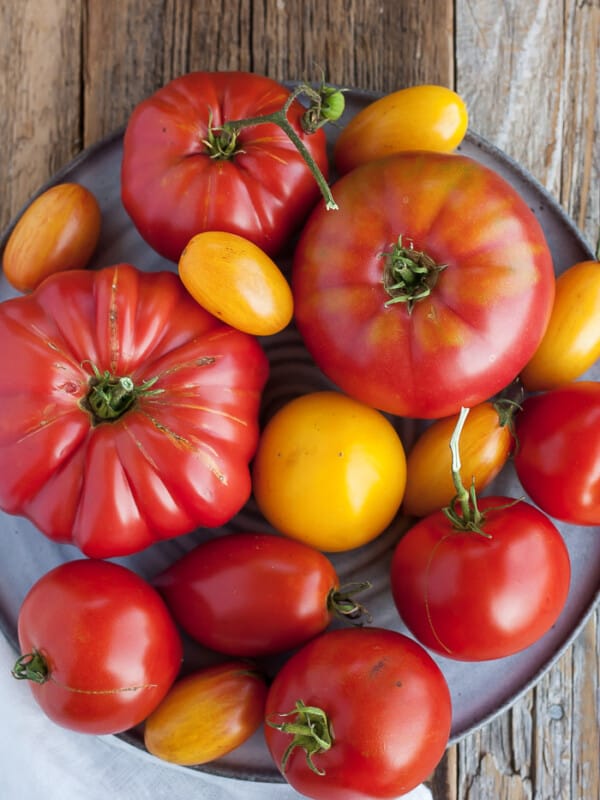
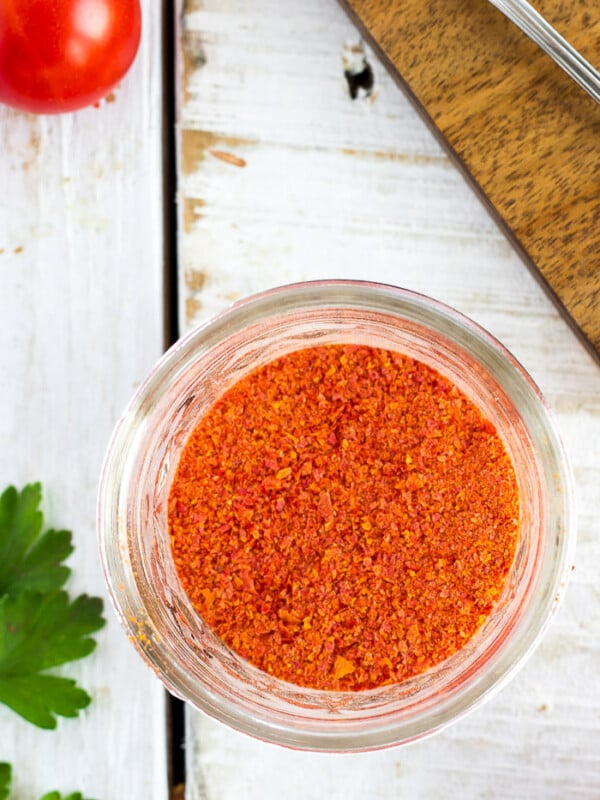
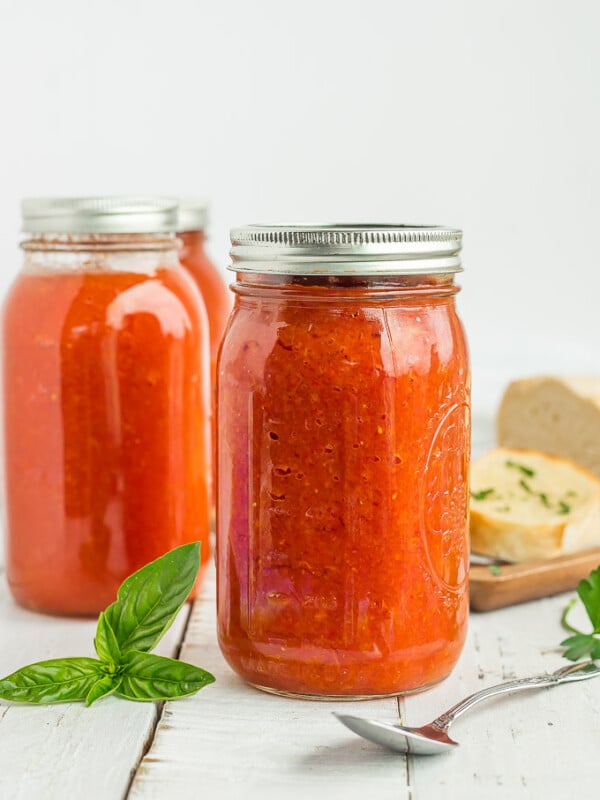








Hi Sarah! My wife and I tried canning and now we’re kinda hooked! Your instructions are great but I had a question. How big is your canner? What I’m getting at is you say to add 3 quarts of water. Is that standard or do you use a really big one? We’re looking to buy one and my thought is go big or go home. Thoughts?
Hi Joe, welcome to the cult! 🙂
My pressure canner is 23 quarts. You only need 3 quarts of water when pressure canning. If I was using it as a water bath canner, you’d have a lot more water in there to cover the jars.
Hi! Please check your nutrition label. 252 calories for 1 gram seems a bit much. Otherwise, great recipe!
It calculates it based on 1 quart. Which honestly I don’t anticipate anyone actually eating 1 quart of tomatoes. 🙂
This is timely. I grew a variety this year called “Pomodoro Squisito” which is a San Marzano-type. BEAUTIFUL, and abundant producers. My husband wants to can them whole. Are you squeezing them into the jars to fit more, or leaving a bit of room so as not to distort them? I think they would look beautiful if you could see them in their whole form through the glass, but also want to conserve space.
Thanks for the post!
That sounds like a gorgeous variety! I gently press them down with a spoon to fit a lot in there (to conserve lids), but you can still see them in the jars.
I’m confused about the total grams of carbohydrates and sugars as they seem very high. Is this correct?
The nutrition label is required so that my post doesn’t give an error, but it shows the total nutritional value per quart (32 oz) of tomatoes. I’m guessing most people don’t eat an entire quart of tomatoes at a time, but that is how it defaults for the label.
I forgot to add lemon juice but added salt, do I need to add it and pressure cook them again?
Best safety practices would recommend you recan them with the lemon juice. I’m sorry, I know it’s not what you want to hear!
The acidity of tomatoes is not consistent enough to declare plain canned tomatoes safe.
I canned Roma’s last week, got out the litmus strips to check pH before adding anything, pH was 4.3. Needs do be under 4.5 so we were good. I wouldn’t throw them out, just use them first, in the next 6 months. Interesting that recipes call for lemon juice or other acid additions without even knowing what the tomato pH is or what it needs to be. pH strips will tell you what you need to know. Some varieties need acid, most don’t.
I think very few people go to the trouble of using litmus strips, so the lemon juice is a “catch all” CYA. 🙂
I love canning tomatoes but this year I have an inch or so of water at the bottom of the jar. This is frustrating since I squeeze out the liquid and remove bubbles before I put the tops on. What am I doing wrong?
We call that “tomato pee” and it is totally normal and expected. The tomatoes are just releasing more juice then anyone can squeeze out of them. As long as your jars are sealed you’re totally fine!
love it!
I save all the skins etc and run them thru the Vita mix for sauce. I’m a fan of no waste!
Have you tried a strawberry huller for removing the stems? I have one that looks like small metal tongs with sharp edges, that works really well on tomatoes… and saves time. Like for people who do not enjoy canning 😉
I did can when I had more time at home, now I just bought a second freezer. (we never have power outages here, so that might not work in every area) but I very much can relate to the love of summer vegetables and fruit in winter!
Yes, I do have one. I find myself using the paring knife or the huller interchangeably most of the time. But I really love my paring knife and am pretty comfortable with it.
What is your favorite thing to freeze/put up?
Lol, no need to Hulk it. That’s actually been the question I always have- how tight do I tighten the rings? Thanks for an analogy I’ll remember!
“Finger tip tight”, is what you are looking for. You want the gasses to be able to escape from the jars when in the canner, but in general the lid needs to stay in contact with the jar.